Charles Ling
FedOne: Query-Efficient Federated Learning for Black-box Discrete Prompt Learning
Jun 17, 2025Abstract:Black-Box Discrete Prompt Learning is a prompt-tuning method that optimizes discrete prompts without accessing model parameters or gradients, making the prompt tuning on a cloud-based Large Language Model (LLM) feasible. Adapting federated learning to BDPL could further enhance prompt tuning performance by leveraging data from diverse sources. However, all previous research on federated black-box prompt tuning had neglected the substantial query cost associated with the cloud-based LLM service. To address this gap, we conducted a theoretical analysis of query efficiency within the context of federated black-box prompt tuning. Our findings revealed that degrading FedAvg to activate only one client per round, a strategy we called \textit{FedOne}, enabled optimal query efficiency in federated black-box prompt learning. Building on this insight, we proposed the FedOne framework, a federated black-box discrete prompt learning method designed to maximize query efficiency when interacting with cloud-based LLMs. We conducted numerical experiments on various aspects of our framework, demonstrating a significant improvement in query efficiency, which aligns with our theoretical results.
* Published in Proceedings of the 42nd International Conference on Machine Learning
Event-Driven Online Vertical Federated Learning
Jun 17, 2025Abstract:Online learning is more adaptable to real-world scenarios in Vertical Federated Learning (VFL) compared to offline learning. However, integrating online learning into VFL presents challenges due to the unique nature of VFL, where clients possess non-intersecting feature sets for the same sample. In real-world scenarios, the clients may not receive data streaming for the disjoint features for the same entity synchronously. Instead, the data are typically generated by an \emph{event} relevant to only a subset of clients. We are the first to identify these challenges in online VFL, which have been overlooked by previous research. To address these challenges, we proposed an event-driven online VFL framework. In this framework, only a subset of clients were activated during each event, while the remaining clients passively collaborated in the learning process. Furthermore, we incorporated \emph{dynamic local regret (DLR)} into VFL to address the challenges posed by online learning problems with non-convex models within a non-stationary environment. We conducted a comprehensive regret analysis of our proposed framework, specifically examining the DLR under non-convex conditions with event-driven online VFL. Extensive experiments demonstrated that our proposed framework was more stable than the existing online VFL framework under non-stationary data conditions while also significantly reducing communication and computation costs.
* Published as a conference paper at ICLR 2025
Homophily Enhanced Graph Domain Adaptation
May 26, 2025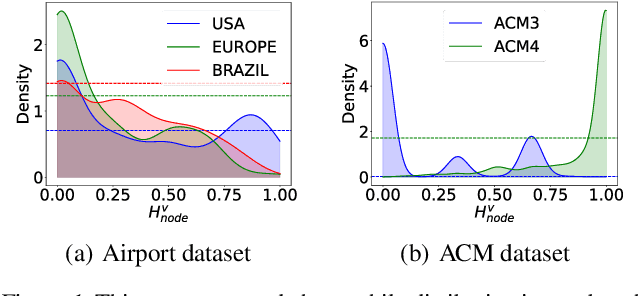



Abstract:Graph Domain Adaptation (GDA) transfers knowledge from labeled source graphs to unlabeled target graphs, addressing the challenge of label scarcity. In this paper, we highlight the significance of graph homophily, a pivotal factor for graph domain alignment, which, however, has long been overlooked in existing approaches. Specifically, our analysis first reveals that homophily discrepancies exist in benchmarks. Moreover, we also show that homophily discrepancies degrade GDA performance from both empirical and theoretical aspects, which further underscores the importance of homophily alignment in GDA. Inspired by this finding, we propose a novel homophily alignment algorithm that employs mixed filters to smooth graph signals, thereby effectively capturing and mitigating homophily discrepancies between graphs. Experimental results on a variety of benchmarks verify the effectiveness of our method.
ZETA: Leveraging Z-order Curves for Efficient Top-k Attention
Jan 24, 2025Abstract:Over recent years, the Transformer has become a fundamental building block for sequence modeling architectures. Yet at its core is the use of self-attention, whose memory and computational cost grow quadratically with the sequence length $N$, rendering it prohibitively expensive for long sequences. A promising approach is top-$k$ attention, which selects only the $k$ most relevant tokens and achieves performance comparable to vanilla self-attention while significantly reducing space and computational demands. However, causal masks require the current query token to only attend to past tokens, preventing the existing top-$k$ attention method from efficiently searching for the most relevant tokens in parallel, thereby limiting training efficiency. In this work, we propose ZETA, leveraging \textbf{Z}-Order Curves for \textbf{E}fficient \textbf{T}op-$k$ \textbf{A}ttention, to enable parallel querying of past tokens for entire sequences. % in both space and time complexity of $\mathcal{O}(N \log N)$. We first theoretically show that the choice of key and query dimensions involves a trade-off between the curse of dimensionality and the preservation of relative distances after projection. In light of this insight, we propose reducing the dimensionality of keys and queries in contrast to values and further leverage $Z$-order curves to map low-dimensional keys and queries into \emph{one}-dimensional space, which permits parallel sorting, thereby largely improving the efficiency for top-$k$ token selection. Experimental results demonstrate that ZETA matches the performance of standard attention on the synthetic \textsc{Multi-Query Associative Recall} task and outperforms attention and its variants on \textsc{Long Range Arena} and \textsc{WikiText-103} language modeling.
Textualize Visual Prompt for Image Editing via Diffusion Bridge
Jan 07, 2025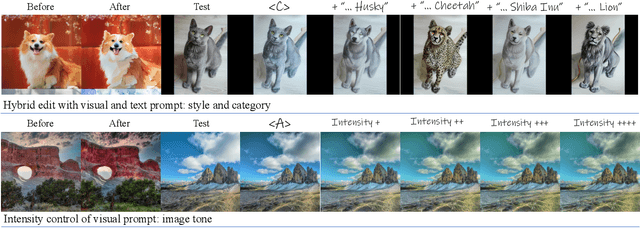



Abstract:Visual prompt, a pair of before-and-after edited images, can convey indescribable imagery transformations and prosper in image editing. However, current visual prompt methods rely on a pretrained text-guided image-to-image generative model that requires a triplet of text, before, and after images for retraining over a text-to-image model. Such crafting triplets and retraining processes limit the scalability and generalization of editing. In this paper, we present a framework based on any single text-to-image model without reliance on the explicit image-to-image model thus enhancing the generalizability and scalability. Specifically, by leveraging the probability-flow ordinary equation, we construct a diffusion bridge to transfer the distribution between before-and-after images under the text guidance. By optimizing the text via the bridge, the framework adaptively textualizes the editing transformation conveyed by visual prompts into text embeddings without other models. Meanwhile, we introduce differential attention control during text optimization, which disentangles the text embedding from the invariance of the before-and-after images and makes it solely capture the delicate transformation and generalize to edit various images. Experiments on real images validate competitive results on the generalization, contextual coherence, and high fidelity for delicate editing with just one image pair as the visual prompt.
Unveil Inversion and Invariance in Flow Transformer for Versatile Image Editing
Nov 26, 2024



Abstract:Leveraging the large generative prior of the flow transformer for tuning-free image editing requires authentic inversion to project the image into the model's domain and a flexible invariance control mechanism to preserve non-target contents. However, the prevailing diffusion inversion performs deficiently in flow-based models, and the invariance control cannot reconcile diverse rigid and non-rigid editing tasks. To address these, we systematically analyze the \textbf{inversion and invariance} control based on the flow transformer. Specifically, we unveil that the Euler inversion shares a similar structure to DDIM yet is more susceptible to the approximation error. Thus, we propose a two-stage inversion to first refine the velocity estimation and then compensate for the leftover error, which pivots closely to the model prior and benefits editing. Meanwhile, we propose the invariance control that manipulates the text features within the adaptive layer normalization, connecting the changes in the text prompt to image semantics. This mechanism can simultaneously preserve the non-target contents while allowing rigid and non-rigid manipulation, enabling a wide range of editing types such as visual text, quantity, facial expression, etc. Experiments on versatile scenarios validate that our framework achieves flexible and accurate editing, unlocking the potential of the flow transformer for versatile image editing.
MABR: A Multilayer Adversarial Bias Removal Approach Without Prior Bias Knowledge
Aug 10, 2024Abstract:Models trained on real-world data often mirror and exacerbate existing social biases. Traditional methods for mitigating these biases typically require prior knowledge of the specific biases to be addressed, such as gender or racial biases, and the social groups associated with each instance. In this paper, we introduce a novel adversarial training strategy that operates independently of prior bias-type knowledge and protected attribute labels. Our approach proactively identifies biases during model training by utilizing auxiliary models, which are trained concurrently by predicting the performance of the main model without relying on task labels. Additionally, we implement these auxiliary models at various levels of the feature maps of the main model, enabling the detection of a broader and more nuanced range of bias features. Through experiments on racial and gender biases in sentiment and occupation classification tasks, our method effectively reduces social biases without the need for demographic annotations. Moreover, our approach not only matches but often surpasses the efficacy of methods that require detailed demographic insights, marking a significant advancement in bias mitigation techniques.
Intersectional Unfairness Discovery
May 31, 2024

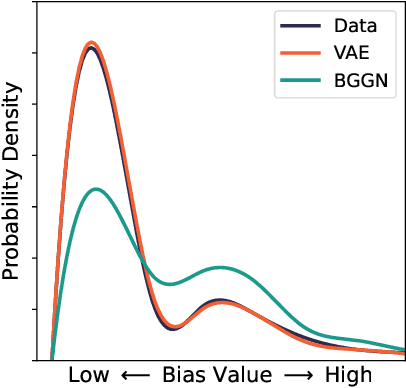
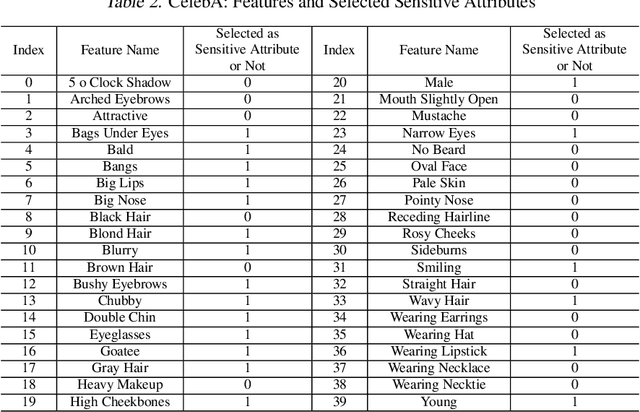
Abstract:AI systems have been shown to produce unfair results for certain subgroups of population, highlighting the need to understand bias on certain sensitive attributes. Current research often falls short, primarily focusing on the subgroups characterized by a single sensitive attribute, while neglecting the nature of intersectional fairness of multiple sensitive attributes. This paper focuses on its one fundamental aspect by discovering diverse high-bias subgroups under intersectional sensitive attributes. Specifically, we propose a Bias-Guided Generative Network (BGGN). By treating each bias value as a reward, BGGN efficiently generates high-bias intersectional sensitive attributes. Experiments on real-world text and image datasets demonstrate a diverse and efficient discovery of BGGN. To further evaluate the generated unseen but possible unfair intersectional sensitive attributes, we formulate them as prompts and use modern generative AI to produce new texts and images. The results of frequently generating biased data provides new insights of discovering potential unfairness in popular modern generative AI systems. Warning: This paper contains generative examples that are offensive in nature.
Toward Open-ended Embodied Tasks Solving
Dec 10, 2023



Abstract:Empowering embodied agents, such as robots, with Artificial Intelligence (AI) has become increasingly important in recent years. A major challenge is task open-endedness. In practice, robots often need to perform tasks with novel goals that are multifaceted, dynamic, lack a definitive "end-state", and were not encountered during training. To tackle this problem, this paper introduces \textit{Diffusion for Open-ended Goals} (DOG), a novel framework designed to enable embodied AI to plan and act flexibly and dynamically for open-ended task goals. DOG synergizes the generative prowess of diffusion models with state-of-the-art, training-free guidance techniques to adaptively perform online planning and control. Our evaluations demonstrate that DOG can handle various kinds of novel task goals not seen during training, in both maze navigation and robot control problems. Our work sheds light on enhancing embodied AI's adaptability and competency in tackling open-ended goals.
Secure and Fast Asynchronous Vertical Federated Learning via Cascaded Hybrid Optimization
Jun 29, 2023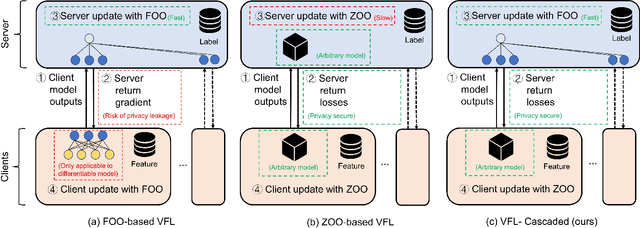
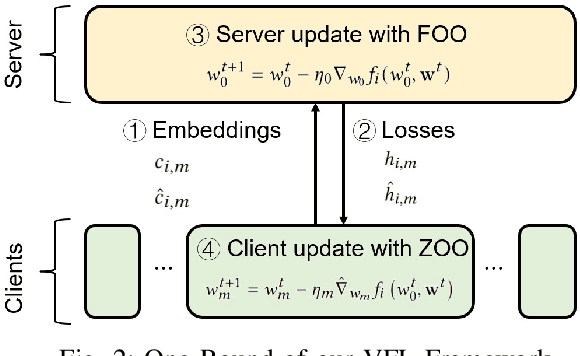
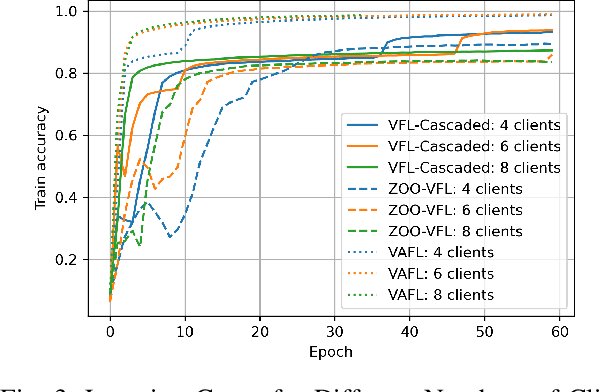
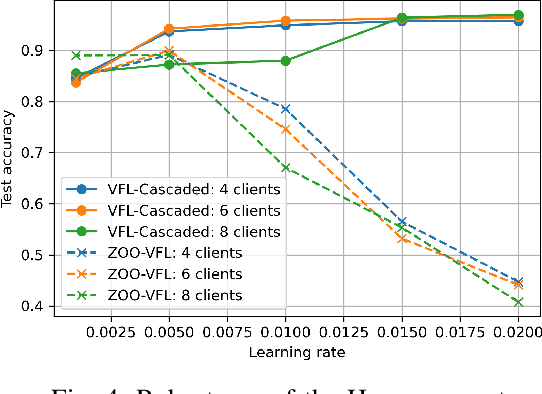
Abstract:Vertical Federated Learning (VFL) attracts increasing attention because it empowers multiple parties to jointly train a privacy-preserving model over vertically partitioned data. Recent research has shown that applying zeroth-order optimization (ZOO) has many advantages in building a practical VFL algorithm. However, a vital problem with the ZOO-based VFL is its slow convergence rate, which limits its application in handling modern large models. To address this problem, we propose a cascaded hybrid optimization method in VFL. In this method, the downstream models (clients) are trained with ZOO to protect privacy and ensure that no internal information is shared. Meanwhile, the upstream model (server) is updated with first-order optimization (FOO) locally, which significantly improves the convergence rate, making it feasible to train the large models without compromising privacy and security. We theoretically prove that our VFL framework converges faster than the ZOO-based VFL, as the convergence of our framework is not limited by the size of the server model, making it effective for training large models with the major part on the server. Extensive experiments demonstrate that our method achieves faster convergence than the ZOO-based VFL framework, while maintaining an equivalent level of privacy protection. Moreover, we show that the convergence of our VFL is comparable to the unsafe FOO-based VFL baseline. Additionally, we demonstrate that our method makes the training of a large model feasible.
 Add to Chrome
Add to Chrome Add to Firefox
Add to Firefox Add to Edge
Add to Edge